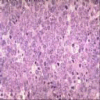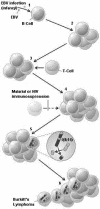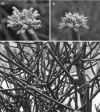Burkitt's lymphoma in Africa, a review of the epidemiology and etiology
- PMID: 18052871
- PMCID: PMC2269718
- DOI: 10.5555/afhs.2007.7.3.166
Burkitt's lymphoma in Africa, a review of the epidemiology and etiology
Abstract
Burkitt's lymphoma (BL) was first described in Eastern Africa, initially thought to be a sarcoma of the jaw. Shortly it became well known that this was a distinct form of Non Hodgkin's lymphoma. The disease has given insight in all aspects of cancer research and care. Its peculiar epidemiology has led to the discovery of Epstein Barr virus (EBV) and its importance in the cause of several viral illnesses and malignancies. The highest incidence and mortality rates of BL are seen in Eastern Africa. BL affects mainly children, and boys are more susceptible than girls. Evidence for a causal relationship between EBV and BL in the endemic form is fairly strong. Frequency of association between EBV and BL varies between different patient groups and different parts of the world. EBV may play a role in the pathogenesis of BL by deregulation of the oncogene c-MYC by chromosomal translocation. Although several studies suggest an association between malaria and BL, there has never been a conclusive population study in support of a direct role of malaria in causation of BL. The emergence of HIV and a distinct subtype of BL in HIV infected have brought a new dimension to the disease particularly in areas where both HIV and BL are endemic. BL has been reported as a common neoplasmin HIV infected patients, but not in other forms of immuno-depression, and the occurrence of BL seems to be higher amongst HIV positive adults, while the evidence of an association amongst children is still disputed. The role of other possible risk factors such as low socio-economical status, exposure to a plant species common in Africa called Euphorbiaceae, exposure to pesticies and to other infections such as schistosomiasis and arbovirus (an RNA virus transmitted by insect vectors) remain to be elucidated.
Figures









Similar articles
-
The investigation of Epstein-Barr viral sequences in 41 cases of Burkitt's lymphoma from Egypt: epidemiologic correlations.Cancer. 1995 Oct 1;76(7):1245-52. doi: 10.1002/1097-0142(19951001)76:7<1245::aid-cncr2820760723>3.0.co;2-d. Cancer. 1995. PMID: 8630905
-
Expression of Epstein-Barr virus-gene products in Burkitt's lymphoma in Northeast Brazil.Blood. 1996 Jun 15;87(12):5279-86. Blood. 1996. PMID: 8652843
-
Epstein-Barr virus and Burkitt's lymphoma worldwide: the causal relationship revisited.IARC Sci Publ. 1985;(60):165-76. IARC Sci Publ. 1985. PMID: 2998987
-
Epstein-Barr virus and the pathogenesis of Burkitt's lymphoma: more questions than answers.Int J Cancer. 2009 Apr 15;124(8):1745-55. doi: 10.1002/ijc.24223. Int J Cancer. 2009. PMID: 19165855 Review.
-
Current investigations and treatment of Burkitt's lymphoma in Africa.Trop Doct. 2008 Jan;38(1):7-11. doi: 10.1258/td.2007.060093. Trop Doct. 2008. PMID: 18302850 Review.
Cited by
-
Pediatric malignancies in Kano, Northern Nigeria.World J Pediatr. 2012 Aug;8(3):235-9. doi: 10.1007/s12519-012-0363-3. Epub 2012 Aug 12. World J Pediatr. 2012. PMID: 22886196
-
Epidemiology and Etiology of Leukemia and Lymphoma.Cold Spring Harb Perspect Med. 2020 Jun 1;10(6):a034819. doi: 10.1101/cshperspect.a034819. Cold Spring Harb Perspect Med. 2020. PMID: 31727680 Free PMC article. Review.
-
Novel replisome-associated proteins at cellular replication forks in EBV-transformed B lymphocytes.PLoS Pathog. 2019 Dec 16;15(12):e1008228. doi: 10.1371/journal.ppat.1008228. eCollection 2019 Dec. PLoS Pathog. 2019. PMID: 31841561 Free PMC article.
-
Bilateral primary breast Burkitt's lymphoma in pregnancy.BMJ Case Rep. 2023 Jan 17;16(1):e251896. doi: 10.1136/bcr-2022-251896. BMJ Case Rep. 2023. PMID: 36653041 Free PMC article.
-
A population-based analysis of hematological malignancies from a French-West-Indies cancer registry's data (2009-2018).BMC Cancer. 2023 Dec 6;23(1):1197. doi: 10.1186/s12885-023-11666-9. BMC Cancer. 2023. PMID: 38057723 Free PMC article.
References
-
- Burkitt D. A sarcoma involving the jaws in African children. Br J Surg. 1958;46:218–223. - PubMed
-
- Burkitt D, O'Conor GT. Malignant lymphoma in African children. I. A clinical syndrome. Cancer. 1961;14:258–269. - PubMed
-
- Bouffet E, Frappaz D, Pinkerton R, Favrot M, Philip Burkitt's lymphoma: a model for clinical oncology. Eur J Cancer. 1991;27:504–509. - PubMed
-
- Jaffe ES, Harris NL, Stein H, Vardiman JW, editors. Pathology and Genetics of Tumours of Haematopoietic and Lymphoid Tissues. Lyon: IARCPress; 2001. World Health Organization Classification of Tumours.
-
- Parkin DM, Ferlay J, Hamdi-Cherif M, Sitas F, Thomas JO, Wabinga H, et al. Cancer in Africa. IARC Scientific Publications No.153. Lyon: IARCPress; 2003.
Publication types
MeSH terms
LinkOut - more resources
Full Text Sources
Other Literature Sources
